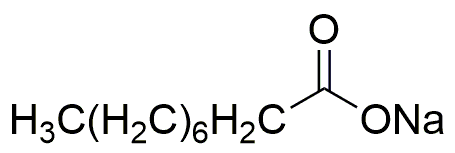Sodium nonanoate is widely utilized in research focused on:
- Food Industry: Used as a food preservative, it helps inhibit the growth of bacteria and fungi, extending the shelf life of products.
- Cosmetics: Acts as an emulsifier and stabilizer in creams and lotions, enhancing texture and consistency while ensuring product stability.
- Pharmaceuticals: Serves as a surfactant in drug formulations, improving the solubility and bioavailability of active ingredients.
- Agriculture: Functions as a biodegradable surfactant in pesticide formulations, improving the spread and adherence of active ingredients on plant surfaces.
- Research Applications: Employed in laboratory settings for various chemical syntheses and as a reagent in organic chemistry, facilitating reactions due to its surfactant properties.
Información general
Propiedades
Seguridad y normativas
Aplicaciones
Sodium nonanoate is widely utilized in research focused on:
- Food Industry: Used as a food preservative, it helps inhibit the growth of bacteria and fungi, extending the shelf life of products.
- Cosmetics: Acts as an emulsifier and stabilizer in creams and lotions, enhancing texture and consistency while ensuring product stability.
- Pharmaceuticals: Serves as a surfactant in drug formulations, improving the solubility and bioavailability of active ingredients.
- Agriculture: Functions as a biodegradable surfactant in pesticide formulations, improving the spread and adherence of active ingredients on plant surfaces.
- Research Applications: Employed in laboratory settings for various chemical syntheses and as a reagent in organic chemistry, facilitating reactions due to its surfactant properties.
Documentos
Hojas de datos de seguridad (HDS)
La SDS proporciona información de seguridad completa sobre la manipulación, el almacenamiento y la eliminación del producto.
Especificación del producto (PS)
La PS proporciona un desglose completo de las propiedades del producto, incluida la composición química, el estado físico, la pureza y los requisitos de almacenamiento. También detalla los rangos de calidad aceptables y las aplicaciones previstas del producto.
Certificados de análisis (COA)
Busque certificados de análisis (COA) ingresando el número de lote del producto. Los números de lote y de partida se pueden encontrar en la etiqueta de un producto después de las palabras "Lote" o "Lote".
Número de catálogo
Número de lote/lote
Certificados de origen (COO)
Este certificado de origen confirma el país en el que se fabricó el producto y también detalla los materiales y componentes utilizados en él y si se deriva de fuentes naturales, sintéticas u otras fuentes específicas. Este certificado puede ser necesario para cumplir con las normativas aduaneras, comerciales y regulatorias.
Número de catálogo
Número de lote/lote
Hojas de datos de seguridad (HDS)
La SDS proporciona información de seguridad completa sobre la manipulación, el almacenamiento y la eliminación del producto.
DownloadEspecificación del producto (PS)
La PS proporciona un desglose completo de las propiedades del producto, incluida la composición química, el estado físico, la pureza y los requisitos de almacenamiento. También detalla los rangos de calidad aceptables y las aplicaciones previstas del producto.
DownloadCertificados de análisis (COA)
Busque certificados de análisis (COA) ingresando el número de lote del producto. Los números de lote y de partida se pueden encontrar en la etiqueta de un producto después de las palabras "Lote" o "Lote".
Número de catálogo
Número de lote/lote
Certificados de origen (COO)
Este certificado de origen confirma el país en el que se fabricó el producto y también detalla los materiales y componentes utilizados en él y si se deriva de fuentes naturales, sintéticas u otras fuentes específicas. Este certificado puede ser necesario para cumplir con las normativas aduaneras, comerciales y regulatorias.

